
Features
Production
Research
Effect of irrigation, soil amendments on early growth, yield of Honeycrisp
soil amendment on early growth, yield of Honeycrisp
May 15, 2008 By Dr. John Cline and Zia Ullah
There is an increasing requirement
in modern, high-density tree fruit orchards to intensify the use of
nitrogenous fertilizers, herbicides, and supplemental irrigation water
to maximize production, precocity and fruit quality.
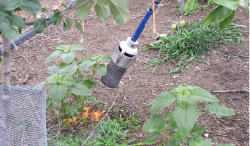 |
| Steam or fire is a relatively new, non-chemical approach to controlling weed growth. The hand-held torch was used to apply the BURN treatment.
Contributed photos |
There is an increasing requirement in modern, high-density tree fruit orchards to intensify the use of nitrogenous fertilizers, herbicides, and supplemental irrigation water to maximize production, precocity and fruit quality. The public today is also demanding reduced use of pesticides in fruit production as exemplified by the increasing demand for organically certified fruit. Growers are also forced to reduce use with increased cost of fertilizer, pesticides, fuel, and other inputs.
An experiment was initiated in 2002 to compare the use of various herbicide‑free practices such as organic and inorganic mulches to traditional weed control methods. Their effects on tree growth, yield and performance over a two-year period were compared with and without trickle irrigation. Determine the environmental and agronomic benefits of various organic amendments and alternative non‑chemical forms of weed control for improving tree establishment, vigour, precocity and yield of apple trees.
One-year-old Honeycrisp apple trees (whips) on M.26 EMLA rootstock were planted at the University of Guelph Horticultural Research Station in Simcoe, Ont., in the spring of 2002 at a spacing of 1.83 metres by 4.5 metres (1,213 trees/ha). Fertilizer and lime were applied based on soil analyses before planting. The soil was classified as a Brady sandy loam with imperfect drainage with low water and nutrient-holding capacity. Trees were trained using a slender spindle training system with individual tree supports.
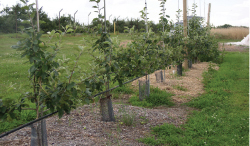
|
| In terms of irrigation and mulch effects on weed growth, the BURN treatment was ineffective and often harmful to the tree. |
Experimental treatments consisted of two irrigation (+/-) and six mulching treatments (see below) using a split-plot design. Irrigation was established as the main plot and soil/weed management and mulch (SMM) treatments served as the split-plots. Treatments were replicated four times with four trees per experimental unit and one guard tree between each main and subplot.
Soil/weed management treatments included:
• non-residual glyphosate herbicide (360 mg/L Roundup, Monsanto) applied twice annually in May and July (HERB)
• burning of weeds using a propane-
fuelled torch (Model 80 Westorch Mfg. Ltd, Priddis, Alberta) and applied three to five times per season at approximately two- to three-week intervals (BURN)
• gypsum (a recycled water-treatment byproduct, Sternson Chemicals, Brantford) applied to a depth of 5 cm and 1 m on each side of the tree (0.14 g/cm3 fw basis; 237 kg/tree, 289 MT/ha) (GYP)
• pine and spruce wood chips (2-4 cm in size) applied to a depth of 10 cm and 1 m on each side of the tree ( 0.19 g/cm3 fw basis; 156 kg/tree, 190 MT/ha) from recycled pallets (WC)
• paper mill biosolids applied to a depth of 10 cm and 1 m on each side of the tree (0.43 g/cm3 fw basis; 354 kg/tree, 430 MT/ha) (PM) straw mulch applied to a depth of 15 cm and 1 m on each side of the tree (approx. 10 kg/tree, 12 MT/ha) (STRAW)
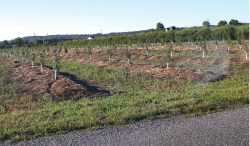 |
| Heavy mulching of young trees with straw is common in Niagara to aid in tree establishment. |
Trees receiving irrigation were trickle irrigated with two litres per hour in-line pressure compensating emitters (Netafim, USA), spaced every 45 cm. Trees were irrigated for a total of 80 minutes daily when rainfall was less than 25 mm per week (based on the previous week).
Each April, the trees were fertilized with ammonium nitrate at the OMAFRA recommended rate of 100 and 175 g NH4N03 per tree in 2004 and 2005, respectively.
Results
In this two-year study, tree growth was not influenced greatly by irrigation or mulch treatments. Trees that received the BURN treatment had less growth and smaller canopy volumes. No negative growth effects were observed from high rates of GYP, PM, and WC. Trees that received the STRAW mulch sustained more rodent injury in the winter when there was snow cover in spite of the use of metal tree guards.
Soil moisture levels at 0, 15, 30, and 50 cm from June through September varied considerably within the soil profile based on date, depth, and treatment. Soil moisture levels early in the season were not significantly affected by irrigation or mulch treatments primarily because of ample rainfall. Generally, when soil levels declined, HERB, BURN, and straw mulch treatments had lower soil moisture levels compared to WC and PM.
Trickle irrigation did increase tree growth or yields in either year. This is not surprising because of ample rainfall. In one of two years, yields from the HERB treatment were greatest, while yields and fruit size from the BURN treatment were lowest both years.
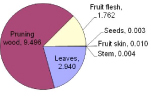 |
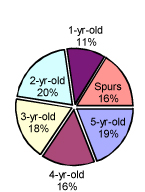 |
|
| Figure 1. Typical removal of nitrogen by a 2-yr-old Apple tree. Total = 14.2 gram N/year |
Figure 2. Typical amount of stored nitrogen (N) in a 4-yr-old ‘Honeycrisp’ Apple Tree/M.26 rootstock. Total = 17.2 grams N. |
In 2004 and 2005, leaf and soil analyses indicated that GYP treatments have resulted in greater tree uptake of calcium, leading to higher leaf Ca levels. Few studies have demonstrated that soil Ca levels can increase leaf Ca levels. It was, however, evident that this did not translate into higher fruit Ca levels based on fruit tissue analysis.
There was no significant treatment effect on soil nitrate levels, as extracted and analyzed from suction lysimeters.
Nitrate concentrations were variable and inconsistent among treatments and
between sampling dates.
Based on the tree partitioning and fruit analysis data, it was concluded that the measured removal and storage rates of actual nitrogen per hectare are 6.9 and 8.4 kg/tree, respectively. The recommended rate of N input is considerably higher because perennial tree fruits are estimated to be 20 to 50 per cent efficient at utilizing all soil-applied N, and some losses to leaching, nitrification, and soil microbial activity are inevitable.
In order to estimate the total amount of stored nitrogen (by various ages of wood) and what was removed by pruning and by fruit, the nitrogen concentration in the aerial portions was measured. In addition, a representative sample of fruit was partitioned into skin, fruit flesh, and seeds, and the N concentration each portion measured. The total amount of nitrogen removed by a four-year-old Honeycrisp on M.26 rootstock, was 14.2 grams. The pruning wood, fruit flesh, and leaves contributed over 98 per cent to this total (roots were not analyzed in this study).
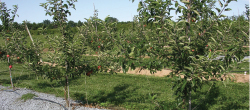 |
| Experimental use of paper mill biosolids as a surface-applied mulch (on Royal Gala/M.9) within the herbicide strip has demonstrated improved water conservation, and some suppression of weed growth. This material decomposes more slowly than wood chips or straw mulch. Contributed photo |
The total amount of N stored in the various vegetative tissue (excluding leaves) in the aerial portion of the tree was 17.2 grams. Wood that was five years old contributed 19 per cent to the total, while one-year-old wood contributed 11 per cent. The contribution towards the total stored N in the other ages of wood ranged from 15 to 21 per cent. This data must be considered in the annual application on N to the orchard, particular if rates for N are based exclusively on removal rates only, and do not consider the N stored in the various components of the tree. The data generally agrees with previous reports of nutrient storage and removal for other cultivars in New Zealand.
In terms of irrigation and mulch effects on weed growth, the BURN treatment was ineffective and often harmful to the tree. Overall, the HERB treatment had the least amount of weed growth while the other soil management/mulch treatments resulted in intermediate weed growth. With the exception of the STRAW mulch treatment, treatments that received irrigation had greater weed growth in comparison with non-irrigated plots. Propane burning was ineffective for control weeds, while WC, GYP and PM were equally efficacious.
The merits of each of the various mulches for commercial growers will ultimately be determined by cost, availability, ease of application (and re-application in instances such as straw), and other indirect benefits realized through water conservation and improvement in soil properties. In Ontario straw mulch is used in some orchards for tree establishment. Wood chips are also gaining popularity and there is also an interest in using paper mill biosolids.
Dr. John Cline is an associate professor of pomology and tree fruit physiology in the department of plant agriculture at the University of Guelph. Zia Ullah is a graduate student in the department of plant agriculture at the University of Guelph. They would like to acknowledge the financial support of the Ontario Ministry of Agriculture, Food and Rural Affairs; The Natural Sciences and Engineering Research Council; and the University of Guelph for funding this research.
Print this page